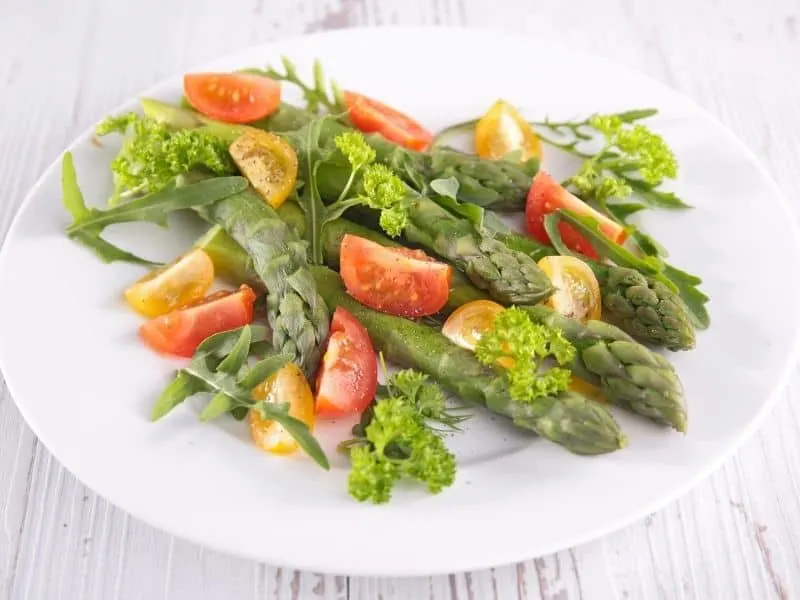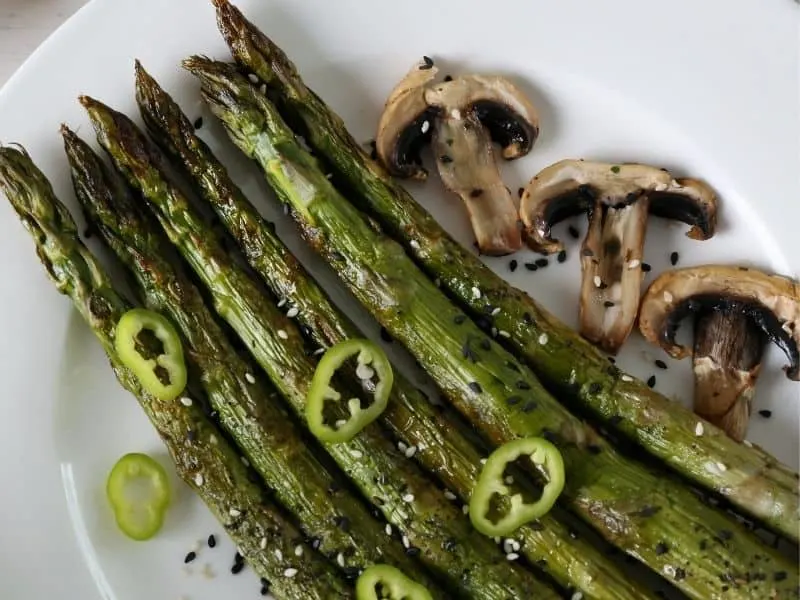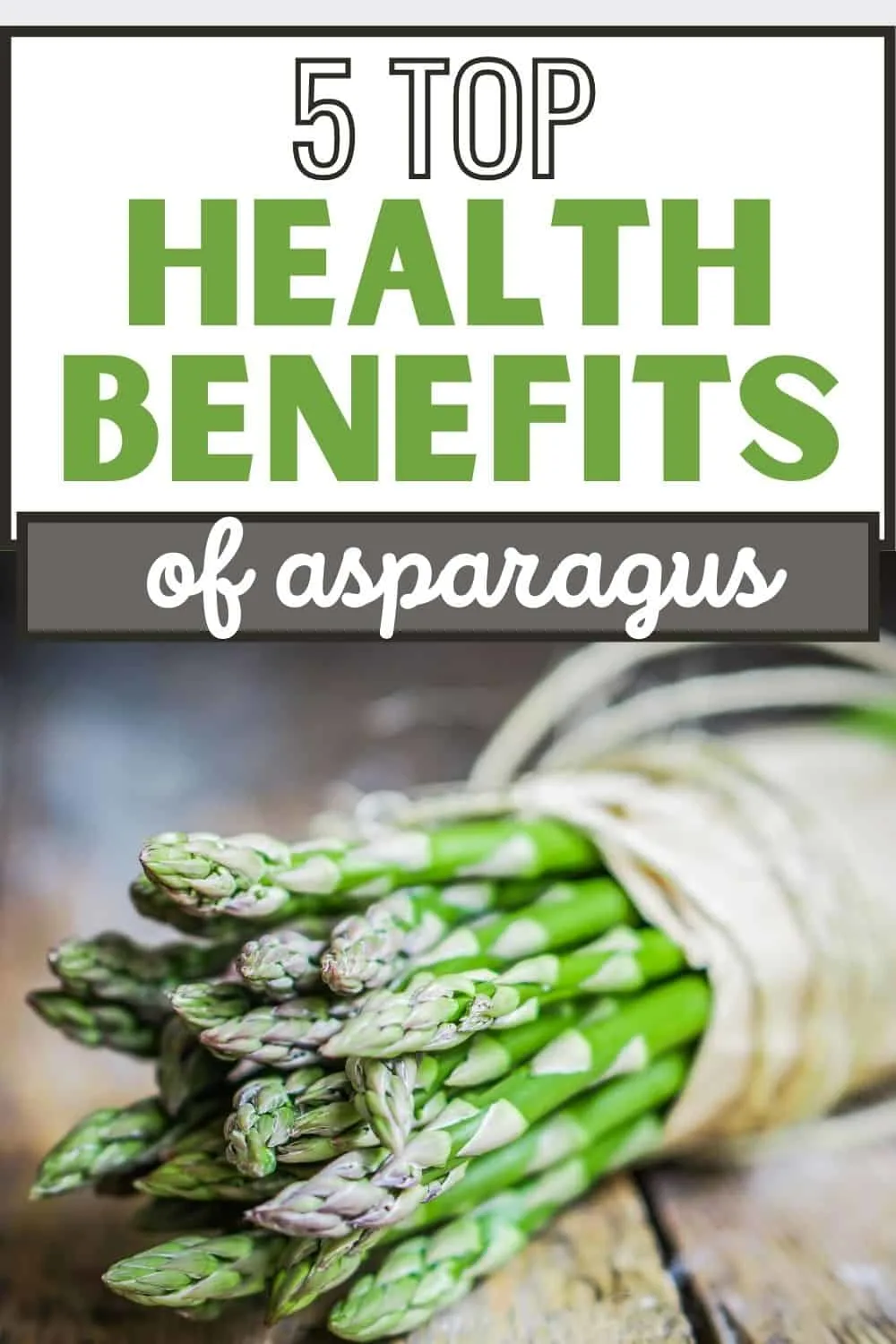There are several health benefits of asparagus and why you should try to add this spear-like plant food to your dinner plate whenever you can.

This tasty vegetable will:
- help keep your immune system healthy.
- lower your cholesterol
- help prevent diabetes, cancer, heart disease
- and then some
Okay, so maybe you don’t care much for asparagus because every time you go to the toilet after eating the food, your urine seems to have an unpleasant odor about it. I’m sure we’ve all experienced that before after eating even a small amount of asparagus. But it’s nothing to be alarmed about, and there’s also no need to go rushing off to the emergency room either.
Asparagus is also an excellent source of folate and vitamin E and contains fructooligosaccharides, (wow! what a name) which help promote the growth of beneficial bacteria in the colon. It is also a natural diuretic.
Did you know that during the 17th century France, asparagus was extremely popular among the royal household, and not just for its incredible fresh taste, but also because the tender spears some thought to be a powerful aphrodisiac?
For asparagus connoisseurs, there’s no better welcome sign when those brilliant green tips start poking their heads above ground. It’s also a welcome sign for your health as well since asparagus contains compounds that can help in the fight against cancer, heart disease, and congenital disabilities.
What Are The Health Benefits of Asparagus?

1. Asparagus is rich in vitamin E
Another reason to add asparagus to your plate is that this veggie contains vitamin E which is great for your heart. Getting just 10 international units of vitamin E a day can substantially reduce your risk of heart disease.
Five spears of asparagus have around 0.4 international units of vitamin E, which is about one percent of the daily value.
While it may be difficult for you to eat a ton of asparagus to get all the vitamin E alone, you also get vitamin E in dark leafy green vegetables such as spinach, swiss chard, and kale, as well as in nuts such as almonds, hazelnuts, walnuts, and pecan nuts.
Seeds such as pumpkin, sunflower, and sesame are also excellent sources of vitamin E, as are avocados, squash, pumpkin, broccoli, and fruits such as raspberries, blackberries, mangoes, peaches, apricots, and guavas.
Vitamin E does a lot more than protect you from heart disease, it may also even help prevent Type II or non-insulin-dependent diabetes. It does this by protecting your pancreas (the organ that produces insulin) and also by influencing how your body burns sugar. People with low levels of vitamin E also run the risk of developing diabetes by nearly four times that of people who get plenty of this vitamin regularly.
2. Asparagus contains folate
The asparagus spears are full of folate, a B vitamin, that is essential for helping your cells to regenerate. Just five spears contain 110 micrograms of folate, which is about 28% of the daily value.
We should all be taking in about 400 micrograms of folate a day for optimum health, and if you’re a woman and are pregnant, you might want to take in as much as 600 micrograms. Not only is folate excellent for women in their childbearing years, but it also helps in the fight against heart disease in men and women.
Folate acts as a floodgate that controls the amount of homocysteine (an amino acid) in the bloodstream. When folate levels drop, homocysteine levels rise, causing damage to the tender arteries that supply blood to your heart as well as your brain. Getting enough folate may be just as crucial for preventing heart disease as it is for controlling cholesterol.
If only we would increase our intake of folate to at least 400 micrograms a day, we would see the number of deaths caused by heart disease drop considerably. Would you believe it if I said that only about 12% of people in the western world are getting that amount?
Now, you don’t have to get all your folate from asparagus: other foods richly endowed with folate include broccoli, spinach, Bok Choy, and cauliflower to name but just a few.
3. Asparagus contains glutathione, a detoxifying compound
There is a protective substance in asparagus called glutathione. This protein acts as a powerful detoxifying compound that helps remove poisonous free radicals – high-energy particles.
That, when left unchecked, has the effect of ricocheting wildly through your body, scarring and punching holes in your cells, and doing the type of damage that can easily lead to serious cancer. Asparagus is one of those vegetables that is high on top of the list for its glutathione content.
Adding to that, the health benefits of asparagus can help ward off many common health-related problems with its anti-inflammatory properties, including issues such as certain cancers, heart disease, and all types of diabetes.
Not only does asparagus contain substances such as glutathione and folate, but it’s also packed with a lot of other vital goodies like:
- vitamin C
- vitamin B
- vitamin E
- vitamin K
- selenium
- manganese
- calcium
- zinc
- iron
4. Asparagus can help you lose weight
Full of fiber, and low in calories, asparagus is a great addition to your diet if you’re trying to lose weight.
You can eat a lot of asparagus without loading up on calories. I can eat an entire tray of broiled asparagus: so yummy!
5. Asparagus is a great mood booster
Because of its high content of folate and vitamin B, asparagus can help list your spirits. Couple eating asparagus with a bit of time in the garden (tending to your asparagus and other veggies you are growing), and you’ll be in a better mood.
How to store asparagus to get the most out of it
Because folate gets destroyed by exposure to air, heat, or light, you need to take special care when storing asparagus. Place your asparagus bunch in a cup with 1/2″ of water in the bottom and stick it in the fridge. Better yet, eat it as soon as you picked (or purchased) it.
When it comes to cooking asparagus, vigorous boiling isn’t necessary. You also have to remember that this vegetable is incredibly tender, so in order not to destroy too many of the nutrients, you may want to microwave your asparagus instead. Even steaming asparagus can eliminate some of the nutrients.
Since most of the nutrients in asparagus are in the tips, it’s far better to slow cook them upright in a tall container rather than piling them at the bottom of a baking dish. Just add a few inches of water to the pot, cover with a lid and bring to a simmer.
The reason you should keep the tips of the asparagus out of the water is that this way you’ll not only preserve the nutrients but it also helps the stalks cook more evenly as well as much more quickly.
How to best prepare asparagus
Because of the asparagus’ natural freshness, you don’t necessarily need to add butter or a sauce to bring out its delicate flavor. All it needs is quick steam or broil, and you can even eat it raw, straight out of the garden.
Although you can eat asparagus from top to bottom, the last bit of the stalk can be slightly woody and sturdy. It’s best to discard that part. The easiest way to do this is to bend the stem which should naturally snap off where the inflexible end stops, and the tender part starts.
However, if the spears are thick, the snap method could waste the perfectly good flesh. To preserve more of the stalk, use a vegetable peeler to peel the bottom area of each spear. Using a sharp knife, you can easily prod the point where the flesh turns woody. Then cut the bottom off there.
1. Add it to your salads raw

This is the easiest! Add a few fresh spears to your daily salad, for some added nutrition and fiber.
I always eat some while picking it, straight out of the ground!
2. Broil it for a quick treat or side dish

Wash, trim, sprinkle with salt and pepper, and broil for 5 minutes turning once. It’s THAT simple! You can eat this as a snack, or add it as a side dish.
Learn more about cooking asparagus.
3. Make asparagus quiche

Our asparagus doesn’t often make it past broiled or in salads, but occasionally, I prepare a garden quiche and add asparagus to it too. Very tasty and colorful.
4. Use the woodier parts to make asparagus soup

I personally have a hard time throwing good food away. So, I use the harder parts of the asparagus to make cream of asparagus soup. It’s a must-try at least once in the spring!
Disclaimer
Please take note that the information on this page is designed for educational purposes only. This information is by no means a substitute for medical care by a licensed healthcare provider.

Adriana Copaceanu is a passionate nature lover living in the country on her dream property where she grows vegetables, lavender, and wildflowers that she shares with the wildlife they attract. When she's not in the garden, she loves spending time with her chickens and planning her next nature project. Check out her books below:
How to Grow Lavender for Fun and Profit: Lessons Learned from Planting Three Hundred Lavender Plants

Tips For Celebrating National Asparagus Month This May
Wednesday 28th of April 2021
[…] Benefits of eating asparagus […]